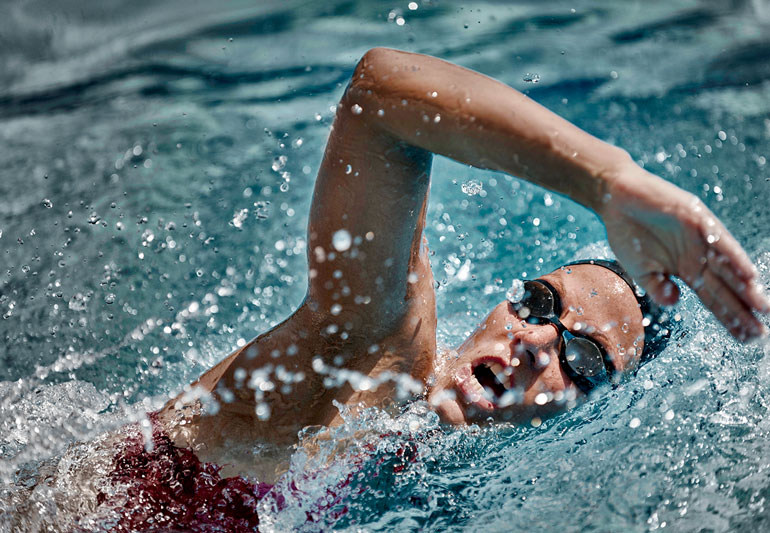A aggressive swimmer could swim six to eight miles a day in coaching and simply rack up 1 million strokes per 12 months within the pool. Those numbers usually equal one thing else, too: Shoulder issues.
Cleveland Clinic is a non-profit educational medical heart. Advertising on our web site helps help our mission. We don’t endorse non-Cleveland Clinic services or products. Policy
An estimated 65% of swimmers cope with an injured shoulder sooner or later. The cause? Overuse. Rotating shoulder joints over and over and over can take a toll on even the fittest athlete.
So, how will you keep away from swimmer’s shoulder with out simply limiting your laps? Let’s dive into the query with bodily therapist Kelly Kinsey, DPT.
What is swimmer’s shoulder?
Your shoulders work as an intricate and unstable community of tendons, muscle tissues and bones. Many shifting elements give these ball-and-socket joints an unbelievable vary of movement. In truth, no different joint in your physique can match the shoulder’s motion.
An exercise resembling swimming, nevertheless, can push your shoulders past their bodily limits.
Repeated arm motions in opposition to the resistance of water can depart shoulder tendons infected and swollen, says Kinsey. This swelling can press on different tendons or close by bones and muscle tissues, resulting in what’s referred to as shoulder impingement.
Tiny tears could finally develop in tendons and muscle tissues. The injury gums up the works in your shoulders, making fundamental motion harder.
Symptoms of swimmer’s shoulder embody:
- Muscle weak point or fatigue.
- Reduced vary of movement.
- Shoulder instability.
- Shoulder ache.
Tips to stop swimmer’s shoulder
If you’re splashing by way of one million swimming strokes per 12 months in a pool, it’s secure to say that you just’re in danger for an overuse damage, notes Kinsey. But there are methods to reduce that danger whereas coaching.
Focused conditioning
Want to stop swimmer’s shoulder? Then work on constructing energy and stability in your shoulder girdle, that means the muscle tissues inside and surrounding your shoulder.
Shoulder girdle weak point can contribute to a defective swimming stroke. A breakdown in type can put elevated stress in your rotator cuff and biceps, beginning a series response that may finally result in damage.
The following workouts may also help construct shoulder energy and enhance positioning:
Wall slides with exterior rotation
This train will assist enhance scapular alignment and shoulder rotation.
- Stand dealing with a wall. Bend your arms at a 90-degree angle in order that your elbows, the aspect of your forearms and pinky fingers are in opposition to the wall. (Your thumb will probably be stating towards you.) Your arms needs to be shoulder-width aside.
- Slowly slide your arms up the wall then again to the 90-degree angle. Keep your arms in touch with the wall as they go up and down. Your arms ought to stay parallel as they transfer. (Option: Loop an train band round your forearms to maintain them in place.)
- Repeat the motion 5 occasions per set, holding your again straight through the train. Don’t lean ahead. Complete three units.
Lying lat pull down (with towel)
This train strengthens underutilized higher again muscle tissues and your shoulder girdle.
- Lie face down on the ground. Extend your arms out as if you happen to’re Superman flying. Hold a towel in each arms, which needs to be positioned barely wider than shoulder-width. Keep the towel taught.
- Bend your arms, holding them parallel as you pull the towel towards (and below) your chest. Arch your again up barely through the motion, permitting the towel to slip beneath.
- Repeat 5 occasions for 3 units.
V arm increase
This train will interact essentially the most muscle tissues in your shoulder girdle.
- Begin in a standing place. Stretch out your arms and produce your arms collectively to create a V form. Keep your thumbs pointed up.
- Slowly increase your arms up the ceiling, sustaining the V form. (Just lifting the load of your arms is sufficient at first. Later, be happy so as to add a 1- or 2-pound weight, or pull a can out of the pantry.)
- Return to the beginning place. Repeat 5 occasions.
Stretching
Most swimmers don’t lack flexibility and truly tend to be hypermobile, says Kinsey. The secret is to not overdo it whereas stretching.
A mild 5 to 10-minute higher extremity warm-up needs to be sufficient to extend blood stream and put together your muscle tissues earlier than a exercise. Try to keep away from accomplice stretching, which tends to be too aggressive.
Don’t practice by way of ache
Training can deliver an anticipated quantity of muscle fatigue and even some aches. But there’s a distinction between a “good” soreness and early signs of great damage, which might embody:
- Decreased vary of movement.
- Weakness.
- Pain.
If the signs appear irregular, attempt to decide any contributing components. Was the depth of your exercise greater, as an illustration? Or did you add miles to your coaching or change your stroke mechanics?
If there aren’t any good explanations for the signs, ease off coaching for just a few days to relaxation your shoulder and let the joint heal. Get checked by your physician, athletic coach or bodily therapist if the break in exercise doesn’t assist.
Ignoring the ache gained’t make it go away. If you proceed to swim with a view to work by way of the damage, your inflammatory response will improve. That’ll make it more durable to diagnose and deal with the damage and make restoration harder.
“You need to pay attention to your body,” advises Kinsey. “The sooner a potential problem is identified and addressed, the better the chance for a quicker and healthier recovery.”

